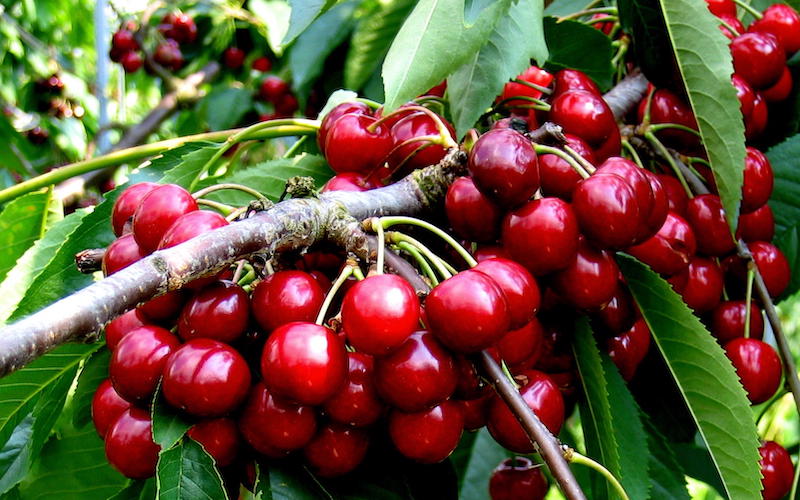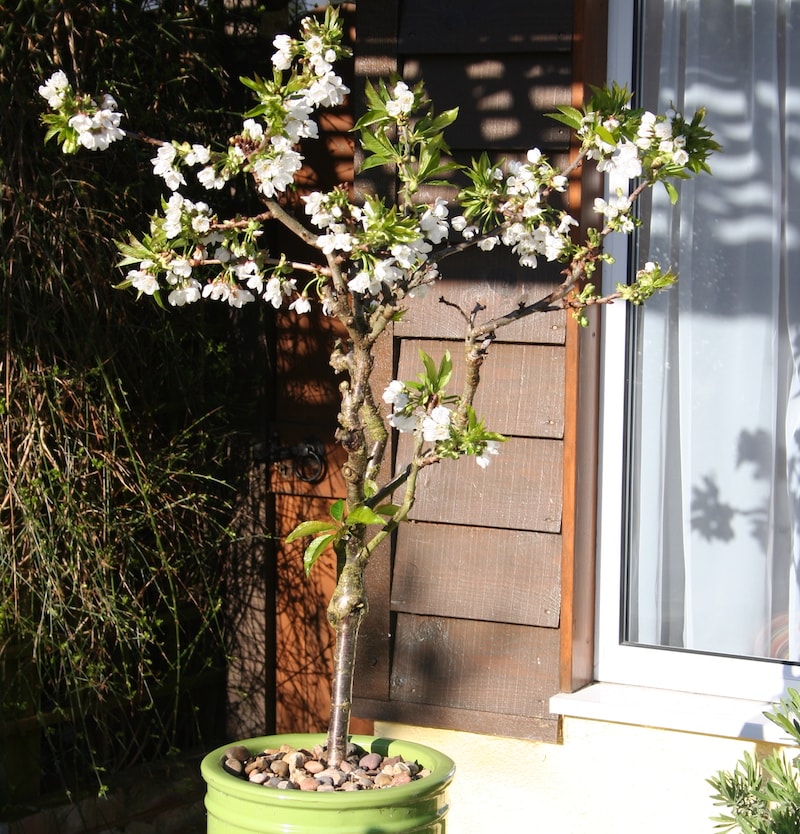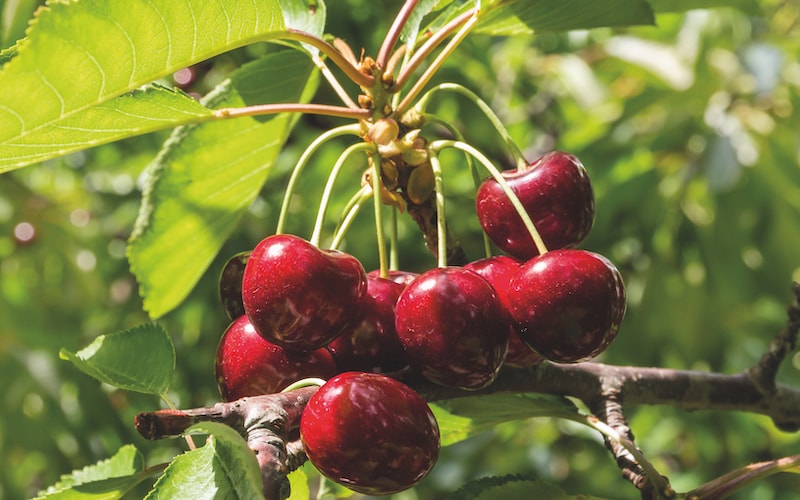In days gone by, cherries weren’t so easy to grow – you’d need an orchard to accommodate the trees and a tall ladder to harvest the fruit (if the birds had left you any). Thankfully, dwarfing rootstocks and self-fertile varieties have changed all that. Now it’s easy to grow your own delicious cherries in a small garden, on an allotment or even in a patio container.
To help you grow your own, here’s a selection of helpful tips taken from our favourite independent articles, videos and Instagram posts. And when you’re ready to plant some new varieties, browse our full range of cherry trees for inspiration.
Contents:
- Best expert advice on choosing the right cherry tree
- Best expert advice on growing cherry trees in the ground
- Best expert advice on growing cherry trees in containers
- Best expert advice on pruning and shaping cherry trees
- Best expert advice on harvesting your cherries
Best expert advice on choosing the right cherry tree

Image: Cherry Tree ‘Summer Sun’ from Suttons
Growing your own cherry tree is much easier than it used to be, as Ben Vanheems of GrowVeg explains in his comprehensive guide to growing your own cherries. Not only are many modern cherry varieties self-pollinating (removing the need for a nearby ‘pollinating partner’), grafting them on to dwarfing rootstocks produces trees of a more manageable size that are “much easier to net against birds, a doddle to prune and, of course, all the easier to harvest”. His recommendations include both sweet and ‘acid’ (sour) varieties, depending on your personal tastes.
My South London Garden is very happy with his ‘Stella’ cherry tree, a low-maintenance variety that requires little pruning and produces “bucketfuls of cherries for two or three weeks”. He and his family either eat the sweet cherries straight off the tree or use them to make jam. Watch this video of his ‘Stella’ cherry tree to see how many fruits you can expect from a dwarf tree in a typical London front garden.
Growing acid cherry trees such as ‘Morello’ requires a similar approach to sweet varieties but there are some key differences to consider, as Pete from Real Men Sow explains in his article on how to grow Morello cherries. For example, Morello cherries aren’t as attractive to birds as sweet varieties, usually ripen later in the year, and fruit on one-year-old wood. Pete wisely advises against winter pruning, which “puts the tree at high risk of developing silver leaf disease and canker”.
The YouTube gardener behind The Small English Country Garden highly recommends growing ‘Morello’ cherry trees as they’re so low-maintenance. Showing her beautiful Morello tree in full blossom, she explains why she rates them so highly. “One of the most incredible things about this tree is that, after you’ve planted it, you can ignore it… You can plant it in your garden, you can leave it, and you can enjoy it.” The tree also provides shelter for small birds and creates a “canopy of beautiful blossom that’s unbelievably gorgeous”.
Excited to see her tree moving on from blossom to buds, Esther is looking forward to a mixture of sweet and acid varieties on her tree, which came “with 5 different varieties grafted onto it”. Follow her journey over at @esthersgardening to see what happens when the fruits come in.
Best expert advice on growing cherry trees in the ground

Image: Cherry (Prunus) ‘Kordia’ from Suttons
‘Stella’ is a favourite of young gardener Natan, who harvested cherries from his tree for the first time in 2022. Having planted it just two years earlier, you can also watch his video on planting and caring for a cherry tree to see how quickly it grows and comes into fruit. Natan recommends planting cherries into slightly acidic soil “because this helps them absorb all the nutrition.” Follow him over at @Gardening_Tips_with_Natan for more great growing tips.
If planting a cherry tree into your lawn, Ben of GrowVeg recommends removing an area of grass at least a metre in diameter so that the young tree won’t have to compete for nutrients, and then digging some well-rotted compost into the planting area: “Mixing this into the whole area, rather than just the planting hole, will encourage roots out into the surrounding soil, helping the tree establish quicker.” Watch Ben’s video guide to planting a bare root cherry tree for more top tips.
Lewis McNeill (The Orchard Project) recommends mulching around young fruit trees as the weather warms up “to reduce competition from other plants and grasses and, importantly, keep moisture in the soil”. In his short and sweet how-to video on how to care for young fruit trees, he puts down woodchip “full of mycelium” in a one-metre circle around the base of the tree, which helps to create the preferred “fungally-dominant soil” beneficial for tree growth and health.
Best expert advice on growing cherry trees in containers

Image: Cherry (Prunus) ‘Hartland’ from Suttons
Kit of Grow With Kit explains that planting bare root cherry trees in pots is “an easy process, but it’s not always explained well on the label”. His helpful step-by-step video on how to plant bare root fruit trees in containers shows him using sand in the bottom of his container to help with drainage. As builders sand can contain quite a bit of salt, Kit says “it’s best to rinse it first before you use it”.
If you’re potting on a container-grown cherry tree, Nick of Nick’s Allotment Diary emphasises the importance of not making the planting hole too deep. In his informative video, he explains that the compost shouldn’t come any higher on the trunk than it did when it was in the pot, as planting too low means “you’ll get suckers coming off the rootstock, which you definitely don’t want, because the rootstock is… a variety different to the main cherry that you’ve planted.”
Over at YouTube channel West London Gardener, Zena adopted a young cherry tree from her aunt’s garden, which is ready to be moved into a larger pot. Her video guide shows how she tackles the process, adding perlite to the mix to improve the drainage. Watch her video on how to repot a young cherry tree to pick up more tips.
At Steve’s Seaside Kitchen Garden & Allotment, Steve’s video tour showing the fruit trees growing in containers in his garden is really inspirational. His cherry trees are grown in galvanised bins, topped with around six inches of woodchip to reduce evaporation. This is a “wonderful way of getting fresh cherries” if you don’t have the space to put them in the ground. Watch the full video to pick up more excellent container-growing advice.
Adam James is pleased with how well his ‘Stella’ has grown over the past months. From the budless stick he planted in a container in February to the beautiful leafy specimen photographed a few months later in May, it is totally transformed. Adam attributes his success to some judiciously applied horticultural fleece “just to protect the roots and help it to take in the soil”. Follow the progress of his growing cherry tree over on @adamandtheplants.
Best expert advice on pruning and shaping cherry trees

Image: Patio Cherry ‘Sylvia’ from Suttons
Summer is the best time to prune your cherry tree. Suttons’ expert horticultural team advise that pruning your tree just once each summer “helps to balance the amount of older fruiting wood and younger replacement branches” and encourages good crops of fruit year after year. Winter pruning greatly increases the risk of canker or silver leaf disease so is best avoided.
In his informative video on pruning and training stone fruit, Jonny of Jonny’s Kitchen Garden demonstrates two different methods of training cherry trees. Fan training creates a fan-shaped tree, while the UFO (upright fruiting offshoots) method involves “laying the main stem down towards the horizontal and then looking for a number of vertical shoots to develop [into] fruiting wood”. Watch his full video to learn more.
Best expert advice on cherry tree pests and diseases

Image: Cherry (Prunus) ‘Morello’ from Suttons
Birds are by far the most problematic pest you’ll encounter when growing cherries, according to Dan of Home Gardens, who has noticed that “pigeons in particular absolutely love them.” In his engaging video, he demonstrates how he covers his ‘Stella’ tree with net curtains to protect a bumper crop: “If anyone out there is throwing away net curtains and you can get hold of them, get hold of them… they let the light penetrate and they keep the birds off.”
Over at @plot_37, Jessie’s young cherry tree is getting ready to flower. Thanks to a combination of well-chosen rootstock and judicious pruning, her tree should be no trouble to protect with a net: “It’s on a semi-dwarfing rootstock and we’ll be keeping it quite tight so it’s easy to cover when the time comes.”
Liam of Allotment Book uses fruit cages to protect cherries and other fruits from bird attack. It’s possible to create an effective bird-deterrent on a budget by using plastic-coated steel stakes, garden wire and standard netting, as his step-by-step guide to making a fruit cage explains. For a more permanent solution, Liam recommends building a steel walk-in fruit cage. Both articles are accompanied by helpful videos that clearly show how to build each type of fruit cage.
Aphids can also be a problem for cherry trees, leading to leaf damage and decreased fruit production. Liam of Allotment Book has a number of suggestions in his video for dealing with aphids, but chief among them is to manage the infestation of ants that almost always accompanies an aphid attack. This is because “ants like to farm aphids, as aphids excrete a sweet liquid called honeydew.” Liam’s simple solution is to apply tree grease around the tree trunk, which prevents ants from climbing the tree and therefore stops them from moving aphids around it.
Best expert advice on harvesting your cherries

Image: Cherry ‘Sunburst’ from Suttons
Most cherries are ready to harvest in July. Adam of Gardeners Tale knows his cherries are ready when they turn a dark red and begin to fall from the tree. It’s fine to pick the cherries off their stalks if you plan to eat them the same day, but to increase their storage life Adam recommends harvesting with the stalks attached. Watch his video on how to harvest cherries to see his clever technique.
Dan Neuteboom of Real English Fruit says you should only pick your cherries once they’ve finished ripening. “Cherries do not ripen off the trees,” so it’s important to resist the temptation to pick them early, even if the birds are circling! Handle the fruits with care and you can store them in the fridge for up to 10 days with the stalks attached.
A beautiful, wildlife-friendly addition to any garden or patio, cherry trees are easy to grow and produce a delicious crop of fruit. Whether yours are smothered in blossom or groaning with fruit, share your images with us via the Suttons Facebook Page.
Lead image: Cherry (Prunus) ‘Stella’ from Suttons
Last Updated on September 30, 2024 by Suttons Horticultural Team





